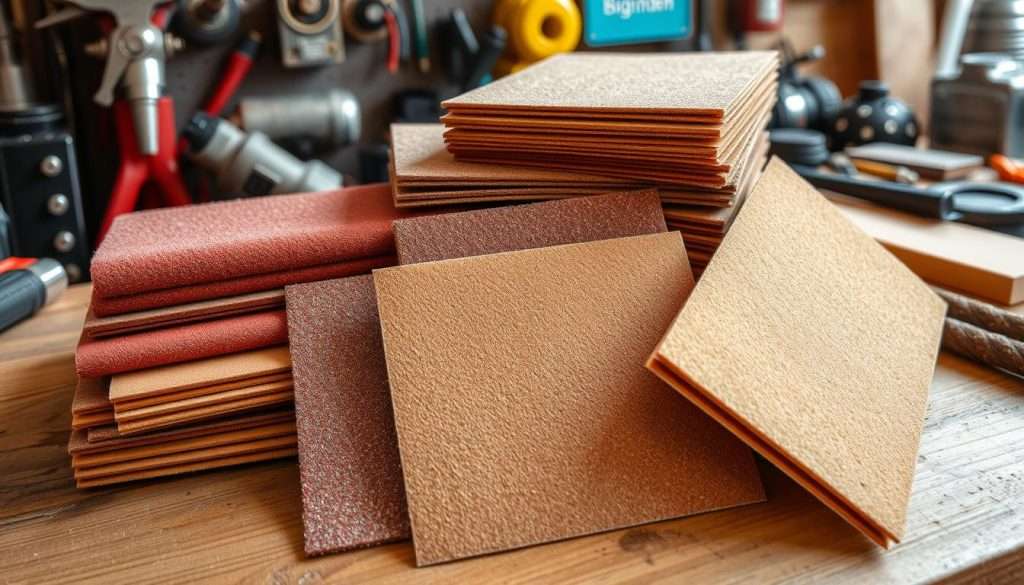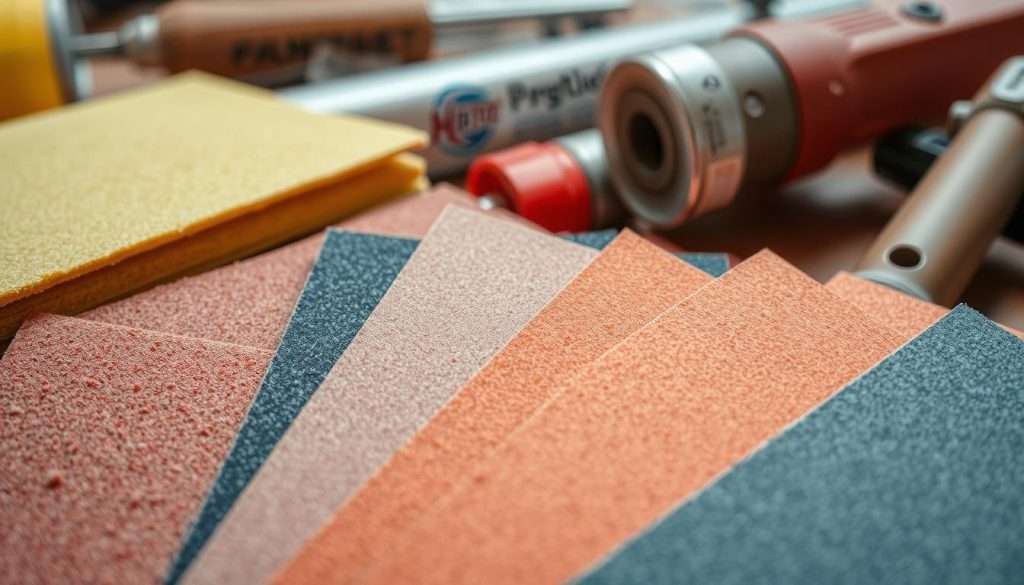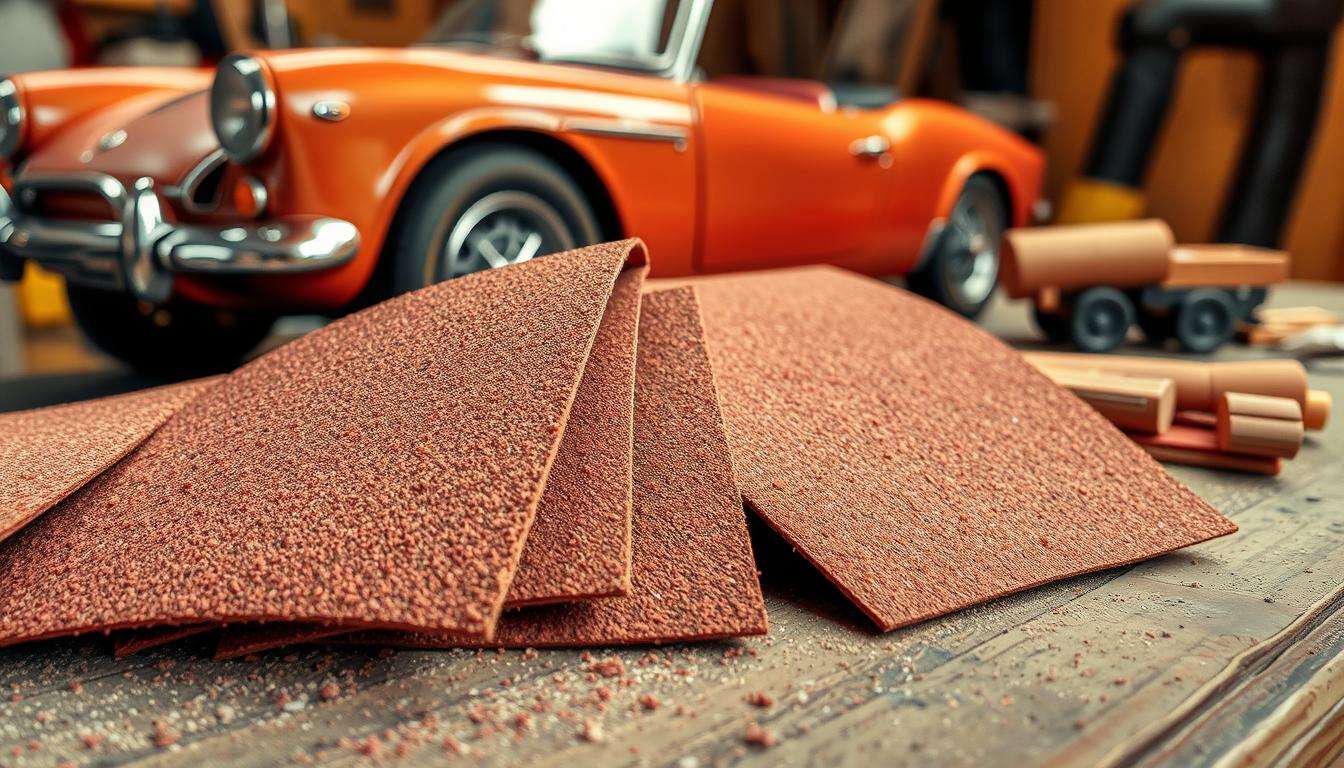When you’re getting ready to paint your car, picking the right sandpaper is key. The grit you choose can make a big difference in how your car looks. Different grits work for different surfaces and finishes.
For big repairs, use sandpaper that’s very coarse, like 24 to 36 grits. This helps fix major problems on your car’s surface.
For older cars with many paint layers, 40-grit sandpaper is best. It’s great for sanding down a lot. Then, switch to 80-grit for a smoother surface. This avoids the rough feel of lower grits.
Even finer grits, like 150 and 240, are needed for a really smooth finish. This is what makes your car look professional.
This article will help you understand sanding grit for car painting. You’ll learn about the different types and how to pick the right one for your project. With the right info, you’ll feel ready to paint your car.
Understanding Sandpaper Grits
Choosing the right sandpaper grit is key for good car surface prep. Each grit size has its own job. Knowing this helps you pick the best grit for painting and get great results.
What is Grit?
Grit is how many tiny abrasive bits are on a sandpaper sheet. A low grit number means it’s rough. A high number means it’s smooth. This affects how well you sand and the car’s finish.
Common Grit Sizes Explained
| Grit Size | Description | Application |
|---|---|---|
| 24-36 Grit | Extra Coarse | Heavy sanding, surface leveling |
| 40 Grit | Coarse | Rust removal, heavily coated vehicles |
| 80 Grit | Medium | Prior paint job preparation |
| 150 Grit | Fine | Feathering after lower-intensity sanding |
| 240 Grit | Very Fine | Final sanding without rough streaks |
The Importance of Grit Selection
Choosing the right grit is crucial for car surface prep. You need different grits for different jobs. For example, using 320 or 400 grit sandpaper ensures good paint adhesion and a smooth finish.
Types of Sandpaper for Automotive Use
Choosing the right sandpaper is key for a perfect car finish. Different sandpapers have different grits and materials. This helps you get your car ready for painting. Let’s look at the main types of sandpaper for cars.
Aluminum Oxide Sandpaper
Aluminum oxide sandpaper is a top pick for cars. It’s tough and lasts long, great for rough sanding. It works well from 40 grit for rust to 320 grit for smoothing before paint.
It wears down slowly, perfect for long projects. Quality and consistency are important here.
Silicon Carbide Sandpaper
Silicon carbide sandpaper is sharp and aggressive. It’s best for hard surfaces and final sanding. It makes surfaces smooth, especially when wet sanding.
Use it from 600 to 1200 grit for primer and base coat prep.
Other Specialized Sandpapers
There are many specialized sandpapers for cars. Here are a few:
- Foam Grip Discs: Flexible and cushioned, great for curved surfaces.
- Flap Discs: Good for rust and shaping metal, smooths surfaces.
- Wet/Dry Sandpaper: Essential for wet sanding, removes scratches and polishes.
Use a car sanding grit guide to pick the right sandpaper. Knowing the types and grits helps you sand well. This ensures a smooth, professional look for your car’s paint job.
| Sandpaper Type | Common Grits | Best Uses |
|---|---|---|
| Aluminum Oxide | 40, 80, 120-180, 320-400 | Bodywork prep, smoothing body filler, leveling filler |
| Silicon Carbide | 600-800, 1000-1200 | Final finishing, wet sanding, primer prep |
| Specialized | N/A | Rust removal, shaping, contouring |
When to Use Coarse Grit Sandpaper
Coarse grit sandpaper is key in the early steps of car painting. It helps deal with tough sanding challenges. Knowing when to use it can make your paint job better and last longer.
Preparing a Heavily Oxidized Surface
Coarse grit sandpaper is great for oxidized surfaces. It ranges from 40 to 80 grit. A 40-grit sandpaper can quickly fix dull and chalky surfaces, making them ready for paint.
Removing Rust and Paint
Rust is a big problem for car owners. Coarse grit sandpaper is perfect for removing rust and old paint. A 40-grit sandpaper can strip away corrosion, stopping further damage. Make sure to remove all rust before moving to finer grits for a lasting finish.
Contour and Shaping Work
Coarse grit sandpaper is vital for shaping body filler. It lets you remove material fast, fixing imperfections. Using coarse grits first helps create the right shape and flatness for painting. Then, use medium and fine grits to smooth out the surface.
The Role of Medium Grit Sandpaper
Medium grit sandpaper is key for car painting prep. It ranges from 120 to 180 grit. It smooths surfaces after coarse sanding.
Smoothing Rough Surfaces
Before primer, smooth out rough spots from coarse sandpaper. Medium grit sandpaper removes imperfections. It makes the surface ready for primer.
It also helps blend body filler edges. This makes the surface smooth. A smooth surface is durable during painting.
Preparing for Primer Application
After smoothing, prepare for primer. Medium grit sandpaper is crucial here. It helps the primer stick well.
A good bond is key for paint to stick. This prevents peeling or flaking. For more info, see this guide on sandpaper for car.

| Sanding Level | Grit Size Range | Purpose |
|---|---|---|
| Coarse Sanding | 30 – 80 | Removing old paint, rust, or heavy imperfections |
| Medium Sanding | 120 – 180 | Smoothing surfaces and preparing for primer application |
| Fine Sanding | 220 – 320 | Refining surfaces and preparing for final paint layers |
Choosing the right grit at each step is important. Proper sanding before painting makes a big difference. It leads to a perfect paint finish.
Fine Grit Sandpaper – Final Touches
Using the right sandpaper is key for a perfect car paint job. Fine grit sandpaper, from 320 to 800 grit, is vital in the final steps. It smooths surfaces well, making your car look professional.
Achieving a Smooth Finish
Fine grit sandpaper makes your car’s finish smooth. It leaves almost no scratches. This helps the paint stick better, making your car look great under any light.
Sanding Between Coats
Painting a car often means using many coats. Fine grit sandpaper is needed to sand between coats. It makes each layer stick well, giving your car a beautiful finish.
Preparing for Buffing
Before buffing, fine grit sandpaper smooths out small paint flaws. It makes your car’s paint look even and shiny. This step makes your paint job look like it was done by a pro.
| Grit Rating | Application |
|---|---|
| 320-400 | Smoothing surfaces before paint application |
| 600-800 | Sanding between clear coat applications |
| 1,000-1,200 | Base-coat sanding |
| 1,500-3,000 | Final polishing before buffing |
The Process of Sanding Before Painting
Sanding your car before painting is very important. It can make a big difference in how it looks. First, you need to check the car’s surface well.
This helps you find any problem areas like rust or uneven spots. Knowing the right sanding grit for car painting makes the surface better for paint.
Assessing the Vehicle’s Surface
Start by looking over the whole car. Look for:
- Rust spots
- Oxidized areas
- Uneven surfaces
This helps you know what to do next for automotive surface preparation. If there’s a lot of rust, you might need to go to a body shop.
Sanding Techniques and Tips
When you’re ready to sand, use these methods:
- Begin with 400 or 600-grit sandpaper.
- Use a sanding block for even sanding.
- Move to 800 or 1000-grit sandpaper for the last touches.
- Let primer dry for 2-3 coats before painting.
This method saves time. It can take 1 to 3 hours for basic cleaning. Or, it might take days for big repairs. Use good auto paints for metal surfaces for the best look.

Apply base coat in multiple coats. Let each coat dry for 5-10 minutes. Then, add a clear coat for protection. These steps help you get a beautiful and lasting finish.
Safety Precautions When Sanding
Sanding your car can get it ready for painting. It’s very important to stay safe while doing this. Wearing the right gear and working in a well-ventilated area helps a lot.
Appropriate Protective Gear
First, you need to wear the right stuff to sand safely. Here’s what you should have:
- Dust Mask: It’s key to keep out harmful dust.
- Safety Goggles: They protect your eyes from dust and debris.
- Gloves: They stop dust and chemicals from irritating your skin.
- Coveralls: They keep your clothes clean and dust-free.
Ventilation and Dust Control
Keeping dust away is also crucial. A good workspace helps a lot. Here’s how to keep it safe:
- Open Windows: Open all windows to let air in.
- Use Exhaust Fans: Fans help blow dust out of the area.
- Dust Extraction Systems: These systems catch dust right where it happens.
- Regular Cleanup: Clean up often to stop dust from piling up.
By taking these safety steps, you protect yourself while sanding. These actions help keep you healthy and make your work better. Knowing the car sanding grit guide and picking the right grits is key for a safe and good painting job.
Tools and Accessories for Effective Sanding
To get your car ready for painting, picking the right tools is key. Sanding blocks and power sanders are must-haves. Sanding blocks help you sand evenly by hand. Power sanders make sanding faster but need careful use to avoid damage.
Sanding Blocks vs. Power Sanders
Think about your project size when choosing tools. Sanding blocks are great for small, detailed areas. Power sanders work well on big surfaces or hard materials. Knowing when to use each tool helps you sand better.
Choosing the Right Backing Pad
The right backing pad is important for power tools. Make sure it fits your sandpaper grits for smooth sanding. The right pad makes sanding easier and safer.
Essential Accessories to Consider
Don’t forget about extra tools that make sanding better. Dust extraction systems keep your area clean and safe. Clamps help hold things in place for better sanding. These tools help you do a great job on your car.
